How to Throw A Throwing Knife: Techniques Anybody Can Learn
So you want to learn how to throw a throwing knife right? Well, whether you want to hit a bulls-eye from some long distance or you want to be an expandable like Jason Statham, you only need some skills and a lot of concentration. Anyway, what many of us don’t know is that the art of throwing knives has always remained a popular leisure activity and it dates back to prehistoric times.
[the_ad_group id=”21″]
You see, throwing knives is not just something that started yesterday, this a practice that has existed for over 100 years now and it has always been perceived as an entertainment method and a sport. This always has been a rewarding and easy to learn hobby.
This is a practice that can be done from anything from a hunting knife to official throwing knives. With all these, the most important thing you should learn first before throwing your first knife is definitely how you should throw it.
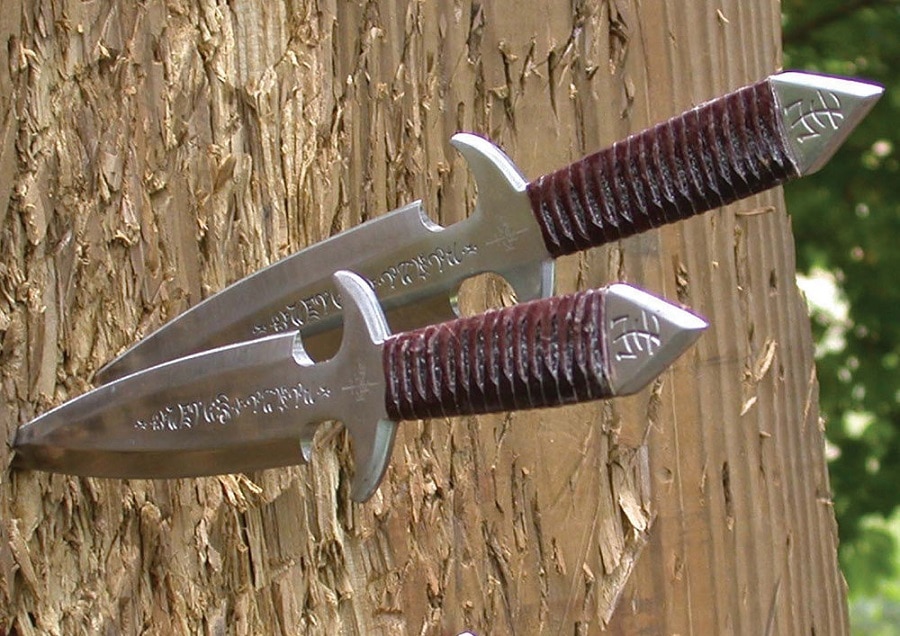
We are going to look at the fundamentals of becoming not just a knife thrower but a professional one for that matter. For you to become a professional, you need to follow some techniques and also do a lot of practice. In this article, we will look at some tips on how to throw a knife.
We will look at some safe and accurate methods of throwing the knife and we shall also go over what you need to know when choosing knives, some safety and throwing basics, type of throws, throwing stance, advanced throws and some general tips as well. Well, here are some of the instructions and techniques that you need to follow in order to become a professional knife thrower.
Choosing A Knife
Before you even start, obviously you must have a knife. You must put in mind that these other common kitchen knives cannot be used for this activity, you will only need a knife that is specially designed and made for this.
If you do not have the required knife, you can also use any knife with a semi-sharp point and has little weight. Using different knives always require different techniques and this is why some throwers often prefer making their own throwing knives.
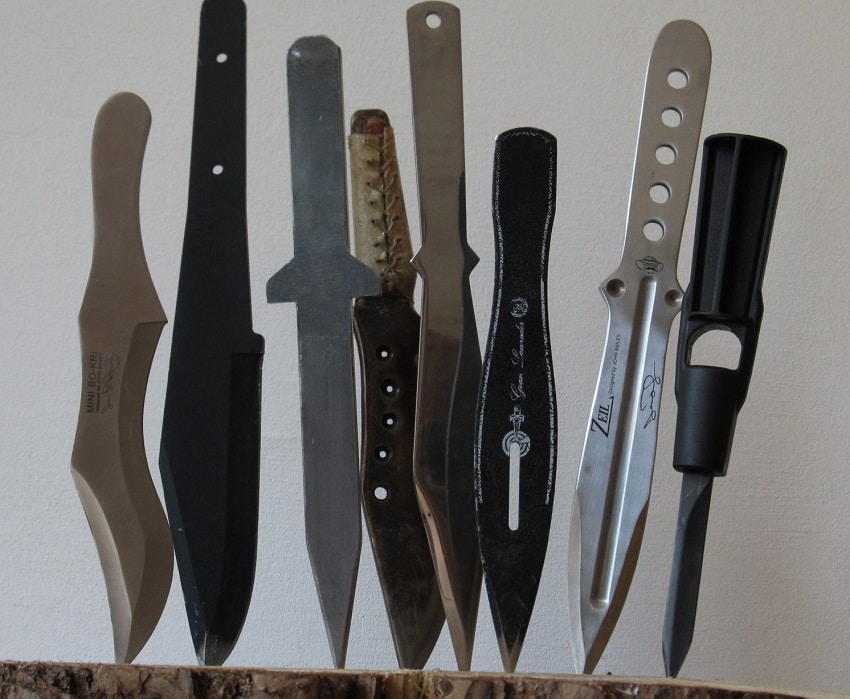
You must also know that the type of knife you choose to use will always have an incredible impact on how much you are able to enjoy the process. Most of the quality throwing knives usually do not have a handle hence the blade is the throwing knife. The ideal throwing knife should be having the following distinctions.
- A sharp point, not sharp edges
- Rounded corners, these are ideal for safety
- Thick enough, this enables the tip not to bend
- The weight should be about 200 grams
- The length should about 12 inches
- Avoid knives with fancy grips and handles
For first time learners, it is always recommended for you to go for simply designed knives with no embellishments as this can help you to be more accurate on your throwing.
As you are going to shop for the knives, always remember to shop for a knife that has the correct specifications including the length, weight and also a knife that will get stuck to your target when you throw it. After finding your ideal knife, you will need a target. The best aiming target to use when practicing your knife throwing skills is usually wood, mostly the soft woods. Check out our experts review of the top throwing knife for your reference.
Examples include cedar, pine, redwood and spruce. Hardwoods are not always recommended since it would make it difficult for the knives to stick when thrown unless you use small knives and use a little more effort to throw. Another thing with using hardwoods for a target is that a knife might bounce off the target when not properly thrown and this might even cause some injuries. Examples of hardwoods are Oak, mahogany, alder, maple, balsa, beech and plywood.
Knife Throwing Goals And Safety Measures
Before you even start throwing knives, you first need to learn exactly what your goal is, how to achieve it and most likely what you need for you to achieve this goal. Perhaps the most important and basic knife throwing goals is always the accuracy first, followed by its ability to stick.
These two can usually be practiced and perfected by regulating the distance between you and the target. This can also be affected by the preferable technique you chose. After you have already worked on these two, you might also want to practice on your consistency.
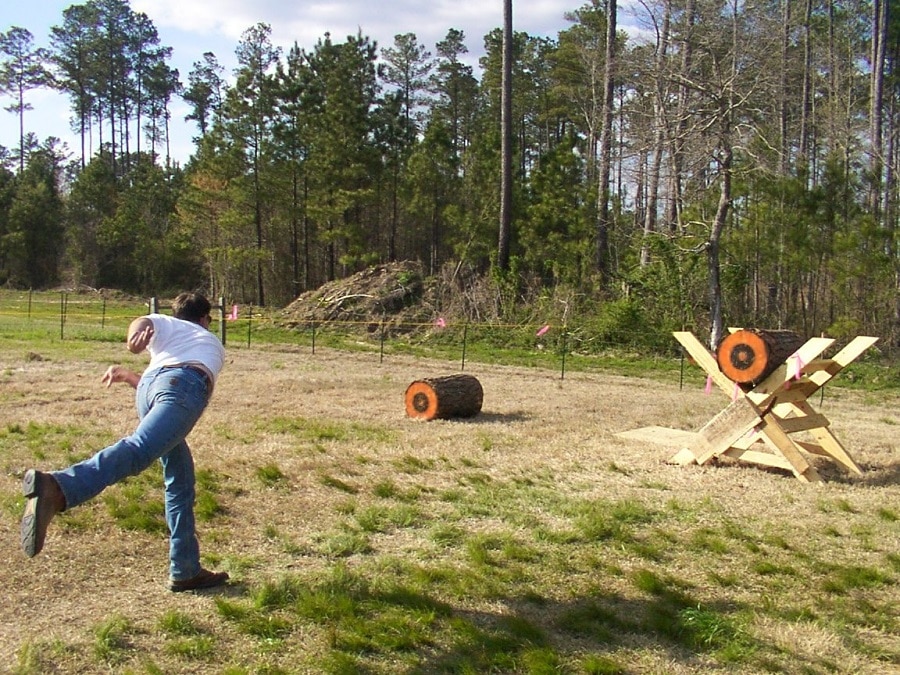
More practice would mean much accuracy rate. With all these in place, you can then start trying different techniques with different knives in order to diversely skilled. When it comes to safety, the first thing you need to use is common sense. See our must-read article on how to throw a throwing knife for more details.
You should not practice barefooted, you should be taking some of your time and go through some quick safety measures before you commence you practice. The following might be some good tips to start with.
- You need to pay attention and put all your concentration in whatever you are doing.
- Make sure you are practicing away far from other people and watch out for the pets too.
- You should ensure that you are using proper equipment.
- You should also alert anyone in the vicinity and let them know about your practicing and the place you are doing it at.
- Make sure you set your targets away from houses, gas grills, cars among others.
- You should also ensure to carry with you a kit that contains a file to help you remove burrs from your knives. Also remember to carry a cloth for wiping both your hands and knives.
- You must also have a first aid kit with you.
We all know that ensuring your safety is an important thing when it comes to knife throwing right? With all that put in place, you can now start focusing on how to achieve your goals. These goals always vary depending on your level of skills.
For you to be able to throw a knife like a professional, there are some instructions that you will need to follow and do a lot of practice. Let us now practice some knife handling and throwing skills.
Knife Throwing Stance And Grip
For you to become a perfect knife thrower, you only need to have a particular form and a certain stance. Just like any other sport, doing your practice is mandatory as this will help you work on things like your body posture and also your footing.
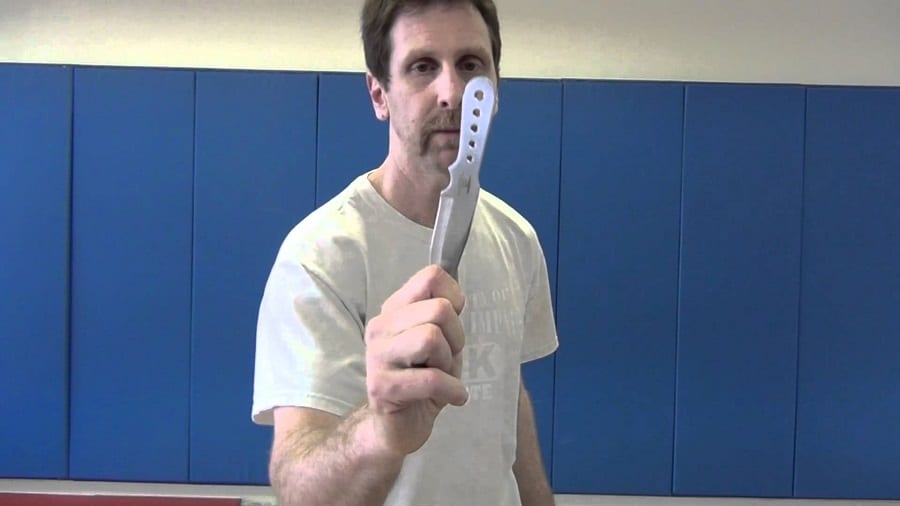
For you to have a good throwing posture you must have the following
- A well-relaxed body, this will help you to focus a lot on your throw thus ensuring consistency in your throwing. On the other hand, having a tensed body will most likely lead to you overthrowing the knife and this might result to inconsistent throwing and you having a bad form too.
- An upright posture, this is always a very vital element in your throwing as it contributes to you throwing your knife in a straight trajectory and accurately.
- If you are right handed, make sure you keep your left foot slightly behind your right foot. Your right foot should also be perfectly placed in front. You should do the opposite when you are using your left hand to throw.
Holding the knife is also a key aspect that you need to focus on while you are throwing. It is often said that for you to hold the knife correctly, you should be holding it a manner same as when you are holding a hammer. You must make sure that your thumb is kept above your remaining fingers and also you need to be keen not to let your fingers does not interfere with your throwing path.
[the_ad_group id=”22″]
It will need you to be more attentive and focused when you want to use a hunting knife. Simple mistakes might cause a lot of things and the worst of them all is you hurting yourself.
It is, therefore, important for you to follow every single detail like leaving a space between your hand and the edge of your blade while gripping the knife. After doing some much practice and understanding on your form and throwing stance, you need to find yourself a pair of shoes, walk out to where your target is and let’s practice a few throws.
Throwing Techniques: Learning The Half Spin Throw
After learning and dong some practice on your stance and form, your next objective will be to throw the knife to your target. The first type of throw we shall look at is the half-spin throw which is also the most popular among the throws. This is the type of throw where the knife undergoes only a half spin while in the air between the target and your hand.
Well, for you to start practicing this throw, you must ensure that you are at the right distance. More often you should be starting at about 15 feet away from your target then later start regulating the distance according to your preference.
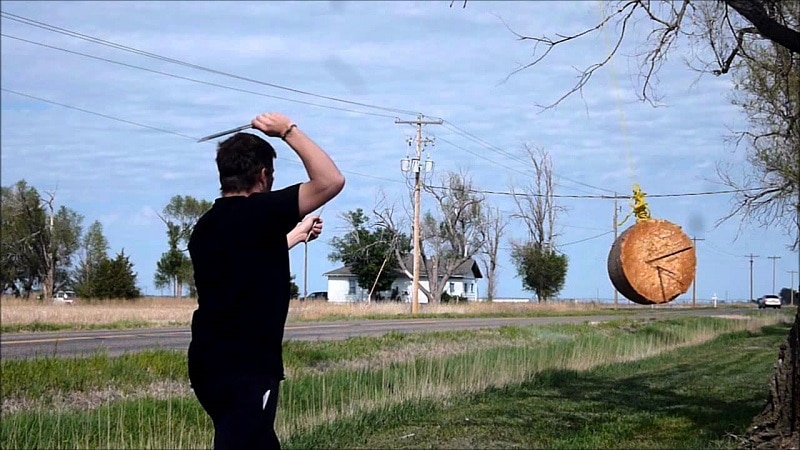
For you to make a nice half spin throw, you need to first assume your stance squaring your shoulders towards the target. Having done this, you now need to grip the knife and hold it up like you are about to hit a nail into a wall with a hammer.
Step into a controlled and steady throw by reaching back a little bit and try not to throw the knife as hard. Watch out not to snap your wrist after simply releasing the knife when it’s already out and in front of you. This should then be followed with a follow through as you would have done when playing baseball.
Congratulations if you manage to stick your knife to your target as you would have made your first successful throw. However, if your knife did not stick to your target and instead bounced off, be sure to check the following:
- Make sure tip of the knife you are using is sharp enough
- You must also ensure that you are using a softwood as your target
- Also, check your distance from the target and make sure it is the right distance
- Focus on your throw and make sure the force you use is enough
Keep making these corrections one at a time until you achieve the right result from your throws. If you are still having some problems getting your knife to stick on the target, maybe here’s a trick that might help you when you are trying hard but nothing seems to work out for you.
You can try and conceptualize the knife’s rotation in the air then make your throw in a manner that will make the rotation force to continue when your knife strikes your target. For the tip to hook and embed deeper into the target, you will basically need to make some changes on your grip to achieve this. This is also recommended when using a handle-grip knife.
No spin throw
A quarter spin technique as it is also known usually have the knife only making a quarter spin while in the air just before striking the target. This only means that for both the grip and the distance you will need to do some adjustments. For this type of spin, you should make sure that your position is slightly closer to the target, maybe halfway closer.
If you were used to throwing the half spin from 15 feet away from the target, you need to adjust this to somewhere around 8 or 7 feet. Different throwers usually prefer different throwing distance so you will just need to adjust accordingly.
https://www.youtube.com/watch?v=KjH2-iCwGTA
For the quarter spin throw, it also has a different grip and it always works more efficiently with a well-balanced knife. You might want to use the following tips when practicing this type of throw:
- Just assume the normal stance you that you are used to.
- Make sure to grip the knife by its handle, putting it between your thumb and your middle’s finger second knuckle. This should be closer to the end.
- Along the handle’s back edge, just near the blade, rest your index finger and naturally curling the rest of your fingers with your hand.
- Hold up your knife with its tip pointing up to the sky.
- At your shoulder is where you need to bend instead of bending at your elbow.
- Continue practicing as many times as you can with your knife’s tip pointing towards the target.
- Your index finger should be pointing to the ground when leaving a follow through at the end of your through.
The quarter spin through is usually a bit difficult compared to the half spin throw. This throw is always known to be less natural hence it will need more practicing for you to be perfect.
Full-spin throw
If you have been practicing well, by now you must be having a very strong throw. This can be confirmed if the tips of the knives you are throwing are sinking deep into the target. Having achieved this, I think it’s time for you to try the full spin. In the quarter spin throw, you were required to move closer to the target but as for the full spin throw, you will need to move far from the target.
If you were doing 7 feet for the quarter spin, you will now double that and move another 7 feet further from the target. The only issue with this type of throw will only be your arm’s length as it must be taken into consideration for this throw. You will need to back up the length of your arm on top of the normal distance you are used to.
You need to keep on practicing your usual throwing procedure until you are able to hit the target accurately and achieve some consistency with your knife’s sticking ability. For this throw also, you will be needed to regulate the variables to get the wanted results.
Spin and a half, and two spin throws
As far as you like, you are allowed to stretch it out but for competitions, you only need two spins. The main variable in the full spin throw is usually the distance, this is for the longer throws then it is followed by some gradual changes to the throw strength and distance.
[the_ad_group id=”23″]
It is usually recommended that you get used to these spins before trying the competition distances which are usually a bit short. You need to put in mind that knife throwing does not involve knives only, it is also not about learning and getting used to your grip, stance, and different throws. Axe and tomahawks throwing are also under the same umbrella of knife throwing.
Several books have been written about the physics and techniques involved in knife throwing and you will also find a lot of information regarding how to make your own knives from steak knives. If in any case, you don’t like competition throwing, you could as well try the impalement arts which involves throwing knives and axes too. Do read our article on the how to choose the best combat knife to give you more options.
You can also learn knife throwing skills for self-defense purposes, only remember to focus and be keen when using the knives.

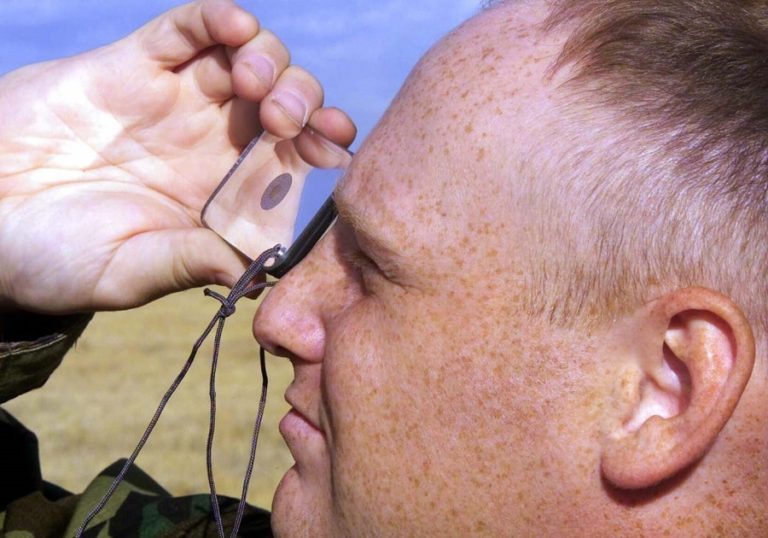





The throwing knife is a serious discipline. You should be composed, be in good shape, and be able to give your maximum effort, at a certain point in time. Mental attitude is also very important. Imagine that you work in front of an audience, this will help you become more focused. To me it often helps.
And try to regularly work on technique. Use your body fully, not just hands.
Throwing knife is one of the most artistic offensive and defensive skills you can learn. It requires precision, concentration, and core strength to be able to let those blades fly. You are absolutely right with the mental attitude because if you cannot focus, you’ll miss the target most of the time.
Throwing knives can be divided into 2 categories depending on what you want to do with them. The first type are professional style knives that are made of steel, look like daggers and don’t have sharp edges. They can be thrown using a handle or a blade.
The second type are sportsman throwing knives. They look like conventional knives, have one blade and are held by handle. So, before you buy one, think carefully how exactly you want to use it.
A great tip, James. There are a lot of throwing knives in the market, but before you buy anything you must be sure which knife fits your level of experience and preference. While they follow the same principle, the finer detail is what sets them apart.